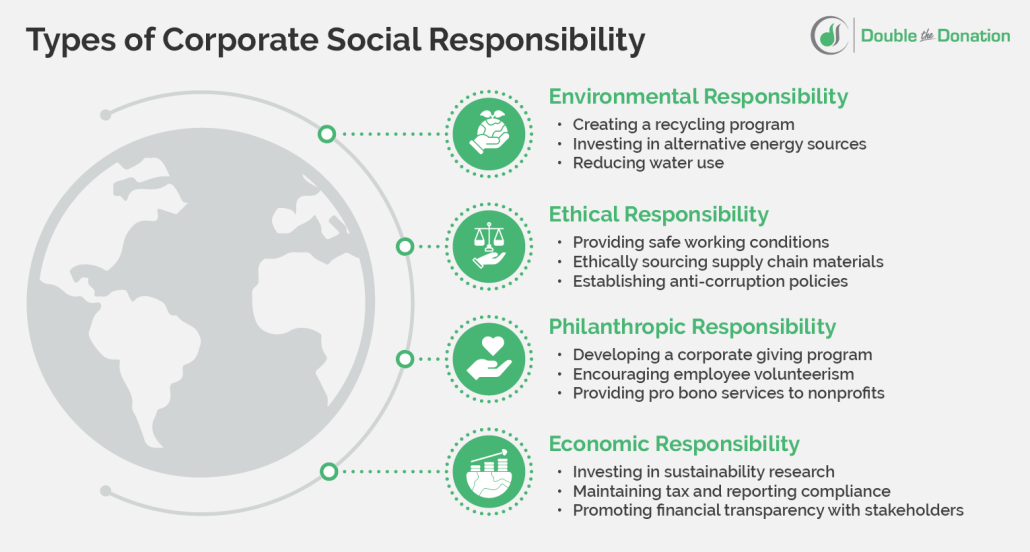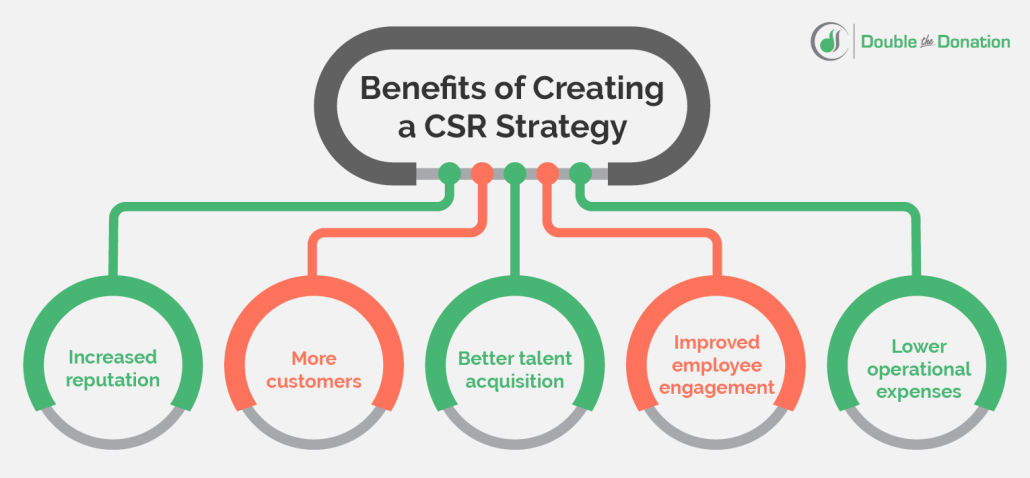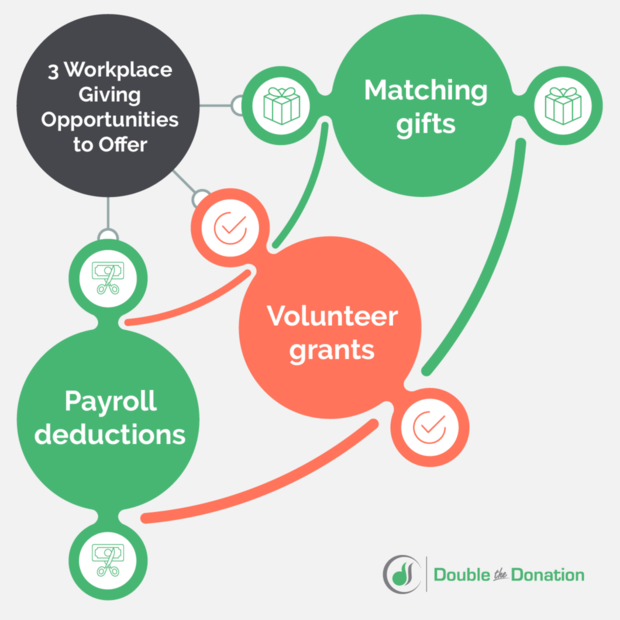Creating a CSR Strategy: How to Forge a Lasting Impact
There are many markers of a successful business—from pulling in huge profits to maintaining highly engaged employees. To truly stand out in today’s society, however, companies must have a strong corporate social responsibility (CSR) strategy. They must demonstrate to employees, customers, and other stakeholders that they are not merely service or product providers, but upstanding corporate citizens with a duty to make the world a better place.
Ready to become a leading company in CSR? We’ll cover everything you need to know about creating an impactful CSR strategy in the following sections:
- What is a CSR Strategy?
- Why is Developing a CSR Strategy Important?
- How to Create Your CSR Plan
- 4 Top CSR Strategy Examples
Your company’s reputation depends on not only how much you make but also how much you give. Philanthropy has become an increasing priority, with corporations donating over $21 billion to nonprofits just in the last year—a 13.4% increase from the previous year. To ensure your long-term success and sustainability, it’s time to solidify what CSR means for your company.
What is a CSR Strategy?
For starters, corporate social responsibility (CSR) refers to a company’s responsibility to operate in a way that enhances the welfare of society rather than harms it. To do so, many companies take conscious steps in areas such as accountability and environmentalism.
A company’s CSR strategy, in turn, outlines the various initiatives and programs it will undertake to improve its social impact. What do these initiatives and programs typically entail? Let’s take a look at four main categories of CSR:
Environmental Responsibility
Environmental responsibility refers to your company’s impact on the health of the environment, from its energy use to waste production. Several common activities that businesses can adopt to increase their environmental responsibility include:
- Implementing more sustainable business practices to reduce pollution and waste.
- Creating a company-wide recycling program.
- Investing in alternative energy sources.
- Reducing water use in the workplace.
- Educating employees about sustainability best practices.
Patagonia is an outstanding company in the realm of environmental responsibility, with an entire page on its website dedicated to its programs and goals. By 2025, the company aims to use only preferred materials, such as organic cotton, that are better for the environment and produce 100% eco-friendly packaging. By 2040, Patagonia aspires to reach net-zero greenhouse gas emissions across its entire value chain.
Ethical Responsibility
Ethical responsibility refers to your company’s treatment of its employees, customers, and other stakeholders. To embrace ethical responsibility, businesses can commit to the following endeavors:
- Increasing transparency surrounding business decisions and finances.
- Prioritizing safe working conditions and fair labor practices.
- Providing all employees with competitive compensation and benefits.
- Sourcing all materials in the supply chain ethically.
- Establishing anti-corruption policies.
Starbucks makes its dedication to ethical responsibility known on its website by including numerous documents on its policies and impact, from its Global Anti-Bribery Standard to data on its workforce diversity. Making all of this information available to stakeholders allows the company to enhance its reputation and build more trust within its communities.
Philanthropic Responsibility
Philanthropic responsibility refers to how your company contributes to making the world a better place. To boost their philanthropic responsibility, many businesses launch the following initiatives:
- Creating a corporate giving program to donate funds to charitable causes.
- Encouraging volunteerism among employees through company volunteering days and volunteer time off (VTO).
- Partnering with nonprofit organizations to fund their events and programs.
- Providing pro bono services to support nonprofit missions.
- Helping nonprofits raise awareness by collaborating in cause marketing campaigns.
TOMS is a noteworthy company that excels in corporate philanthropy, investing one-third of its profits to promote grassroots good. The company partners with nonprofits to support mental health, increase access to opportunity, and end gun violence through cash grants, volunteering, and more. In the last year, TOMS has contributed $1.7 million to its focus areas and impacted 147,510 lives.
Economic Responsibility
Economic responsibility refers to how your company grounds its financial decisions in advancing social good. A few basic ways businesses can enhance their economic responsibility include:
- Investing in sustainability research related to their products or services.
- Maintaining compliance with tax and financial reporting requirements.
- Promoting financial transparency with stakeholders.
- Adopting processes that may be more expensive but are more sustainable.
- Launching training initiatives to educate employees on areas such as diversity, equity, and inclusion (DEI) and environmentalism.
For example, LEGO places significant emphasis on researching ways to increase its sustainability. Over the past few years, the company has collaborated with suppliers and research institutions to create LEGO bricks from more sustainable sources—testing over 300 recycled materials and even creating a prototype brick from PET plastic bottles.
Why is Developing a CSR Strategy Important?
Creating a CSR strategy for your company is not as simple as checking off a box on your to-do list. Considering all the planning and effort involved, is such an endeavor really worth it? The simple answer is yes. By designing a thoughtful CSR strategy, your company can:
- Enhance its reputation. A CSR strategy demonstrates your company’s commitment to creating lasting social change, rather than merely securing profits. This can go a long way toward generating a sense of respect and admiration in the eyes of your stakeholders.
- Attract more customers. As your reputation for social good spreads, you’ll catch the attention of more socially conscious customers interested in supporting your company and its CSR initiatives. Additionally, you’ll be able to win the loyalty of existing customers who share similar values with your company.
- Recruit more top talent. PwC reports that 86% of employees prefer to work for companies that care about the same issues they do. By placing more of a focus on CSR at your company, you’ll be able to better appeal to job seekers who are motivated to make the world a better place.
- Improve employee engagement. Keeping employees engaged has become a major priority for many companies, considering Gallup’s finding that only 32% of full- and part-time employees are engaged, while 18% are actively disengaged. Having an effective CSR strategy allows your employees to take pride in their work and find a larger sense of purpose in their roles. In turn, this can lead them to stick around for the long term.
- Lower its operational expenses. By prioritizing CSR at your company, you can make progress in areas such as energy efficiency, resource consumption, and waste management. With these improved processes, you’ll be able to reduce your operational expenses over time.
Beyond these immediate benefits, a CSR strategy ultimately empowers your company to boost its impact on the world. Your efforts will provide nonprofits with critical funding to fulfill their missions, employees with a healthy and fulfilling work environment, and communities with the support they need to thrive.
How to Create Your CSR Plan
While there are many facets of a CSR strategy, building one doesn’t have to be a complicated task. Follow these eight steps to hit the ground running with your company’s strategy:
1. Set relevant CSR goals.
When building a CSR strategy, it’s important to set clear, relevant goals to maximize your results and avoid overwhelming your team. Think about any existing CSR initiatives you may have within your company. Then, review them alongside your mission and values. Do your activities align with your values? How do they relate to your company’s overarching purpose?
After reflecting on these points, consider setting goals in areas such as:
- Sustainability
- Employee well-being
- Corporate philanthropy
- Supply chain processes
- DEI
Before you can launch your strategy, you’ll need to secure support from members of your board and leadership. Be sure to emphasize the benefits of creating a CSR strategy, including how it will contribute to your business goals as a whole. Reference examples of other successful companies to serve as models for your proposed undertaking.
2. Conduct research and collect feedback.
As you develop your strategy, research relevant topics and issues that your company can have a meaningful impact on. Several frameworks exist to inform your decision-making, such as the UN’s 17 Sustainable Development Goals (SDGs), which include:
- Zero hunger
- Good health and well-being
- Quality education
- Gender equality
- Affordable and clean energy
- Decent work and economic growth
Furthermore, the International Organization for Standardization (ISO) has created a standard to guide companies in developing social responsibility programs. Combine these resources with stakeholder feedback to produce a CSR strategy tailored to your company’s goals and priorities.
To collect this information, send out surveys to your employees, customers, and other community members to learn more about how they view your current CSR standing and what causes are important to them. After all, 84% of consumers and 85% of employees agree that the more a business engages them in charitable giving decisions, the more trust they have in that business.
3. Involve employees with a workplace giving program.
A successful CSR strategy depends on the combined efforts of everyone at your company. Present your employees with direct ways to contribute by creating a workplace giving program. Some basic opportunities you can provide are:
- Matching gifts. This initiative is popular among many businesses, with 65% of Fortune 500 companies offering matching gift programs. When an employee donates to an eligible nonprofit, they’ll submit a request to your company. Then, your company will make a donation of its own, matching the employee’s gift amount at a 1:1 ratio or more. This is a stellar way for employees to secure more revenue for causes they care about.
- Volunteer grants. The process for volunteer grants is similar to that of matching gifts, except your company will make a donation after an employee volunteers a certain number of hours with a nonprofit. Once they pass the minimum hours threshold, they’ll submit a request, and you’ll contribute a certain amount of funds per hour volunteered.
- Payroll deductions. Automatic payroll deductions make it easy for employees to give to nonprofits on a recurring basis. To participate, they’ll select an organization to support and how much they would like to contribute out of their paychecks.
Pave the way for additional team-building by planning volunteer days for your company to take part in. In doing so, you’ll be able to encourage more employees to join in your philanthropic initiatives and cultivate stronger relationships with their peers.
4. Partner with nonprofit organizations.
Enhance your CSR strategy by seeking out partnerships with nonprofits. With the right approach, these partnerships can turn into long-lasting, mutually beneficial relationships. Beyond organizing regular volunteer opportunities with them, you can sponsor their events in exchange for a mention in their marketing materials. Reach out to nonprofits with missions and values that align with yours to ensure that both parties get the most out of the partnership.
For instance, General Mills has been a partner of Feeding America for over 40 years. The company has supported the nonprofit through a variety of initiatives, such as charitable giving, product donations, volunteerism, and more. Since their partnership first began, General Mills has contributed a total of $37 million to advance Feeding America’s hunger relief goals.
Whirlpool, a kitchen and laundry appliance company, focuses its social responsibility on affordable housing. For 23 years, the company has collaborated with Habitat for Humanity by contributing funds, donating products, and creating support programs in 45 different countries.
Both partnerships illustrate the power of collaborating with nonprofits that share similar values and goals with your company.
5. Adopt CSR software.
Since there are many moving parts to an effective CSR strategy, you’ll need to invest in a toolkit to streamline your processes. A comprehensive CSR software solution should equip your company with features that streamline:
- Donation management. Your company should be able to provide its employees with multiple ways to participate in your corporate giving initiatives, including making donations directly through your CSR platform. Additionally, the software should allow you to manage your matching gifts program and automatically approve requests based on your guidelines.
- Volunteer management. Your CSR software should supply your company with tools for planning and promoting corporate volunteer opportunities. Furthermore, look for the ability to accept volunteer grant requests and process them based on the number of hours logged by each employee.
- Tracking and reporting. A key aspect of CSR involves sharing your initiatives and impact with stakeholders. With CSR tools, you can easily generate reports and maintain transparency about your efforts. This information can also prove useful for refining your strategy going forward.
If you’re looking for a new CSR solution to invest in, be sure to conduct thorough research, request demos, and consider integrations that will enable your company to use its technology to the fullest. For instance, CSR providers that offer an auto-submission integration make it easier than ever before for employees to participate in your matching gifts program.
Check out this quick video to learn more about this cutting-edge feature:
As the video explains, auto-submission is an innovative tool that allows employees to automatically submit matching gift requests after they make a donation to a nonprofit. All they need to do is input their company email address, and the technology takes care of the rest—leading to more employee engagement in your workplace giving efforts and a larger impact on your community.
6. Communicate your CSR strategy with stakeholders.
Once you’ve laid a foundation for your CSR initiatives by setting goals, researching nonprofit partnerships, and equipping the tools you need to succeed, it’s time to formalize the details and share them with your stakeholders. Draft a CSR policy that explains your company’s approach to CSR, including:
- Goals and relevant metrics
- Focus areas
- Opportunities for employee participation
- Methods for reporting
Think back to your goals and stakeholder feedback to produce a policy that speaks to their most important interests, priorities, and concerns. Then, share this documentation on multiple platforms for easy access, including your website, employee portal, and social media pages.
7. Prioritize transparent reporting.
Demonstrate to employees, customers, and other community members that your CSR strategy is more than just performative by implementing thoughtful reporting procedures. By leveraging CSR reporting tools, your company can track and report on its:
- Corporate philanthropy funds and impact.
- Workplace giving participation.
- Environmental sustainability.
- Internal business practices.
Make your reports accessible to all stakeholders by producing different versions for different audiences. For instance, rather than forcing your customers to read dozens of pages regarding your CSR impact, design a summary sheet with infographics illustrating the key points of your report. In additional documents, include all the details for those who need or want to know more about your initiatives.
8. Recognize employees for their participation.
Keep your company’s employees invested in your CSR strategy by consistently recognizing them for their participation. Doing so reinforces the value of their contributions and ensures that they continue engaging with your initiatives year after year.
Several effective ways you can cultivate a culture of recognition at your workplace include:
- Sending eCards commending employees for contributing to your CSR efforts.
- Posting social media shoutouts featuring employee names and pictures.
- Adding a section on your website showcasing top employee contributors.
- Presenting awards to the most involved employees in your CSR activities.
Expressing appreciation to employees is an essential practice that benefits your company as a whole. Open up opportunities for peer-to-peer recognition and reach out on important holidays to establish a close-knit community of loyal employees.
4 Top CSR Strategy Examples
As your company embarks on its CSR journey, know that you don’t have to travel it alone. Many other businesses have taken their own endeavors to improve their impact on society and have succeeded with flying colors.
Let’s examine four exceptional examples of CSR strategies to inspire your efforts:
REI
As a consumer’s co-operative, REI’s CSR initiatives focus on improving the working conditions of its employees, the experiences of its members, the well-being of society, and the success of the company. REI’s most recent efforts include:
- Sourcing recycled and renewable materials within the company’s product supply chain.
- Using less energy in stores and distribution centers through smart building design and energy-efficient measures.
- Encouraging product reuse by creating a Re/Supply program for members to participate in.
- Requesting that vendor partners use alternatives to individual plastic bags for product shipping.
In the last year, REI Co-op has contributed $6.9 million to 503 nonprofit partners. Additionally, the company has engaged over 78,000 members of its community in its grassroots advocacy program, sending more than 250,000 messages to state and federal decision-makers. Stakeholders can find key data related to REI’s impact summarized in a straightforward scorecard online.
Microsoft
Microsoft is a top CSR company that focuses its strategy on four commitments:
- Expanding economic growth and opportunity.
- Earning trust through responsible artificial intelligence (AI) usage, privacy protections, and cybersecurity.
- Protecting people’s fundamental rights through responsible business practices and accessibility initiatives.
- Advancing sustainability through technological innovation.
The company allows employees to take part in its philanthropic efforts by offering matching gifts and volunteer grants in its workplace giving program. These opportunities have led to $255 million in contributions to over 32,000 nonprofits in just the past year.
HP
As another company dedicated to CSR, HP produces three separate reports based on its main pillars of focus:
- Climate action
- Human rights
- Digital equity
These reports reveal the extent of the company’s tree-planting efforts, investment in minority- and women-owned businesses, and educational programs to promote digital literacy around the world.
Google is a dominant technology company that has set ambitious goals for its CSR, including:
- Diverting all office food waste from landfills by 2025.
- Making product packaging 100% plastic-free by 2025.
- Running data centers and offices on carbon-free energy 24/7 by 2030.
Furthermore, the company gives $200 million to charitable organizations every year and offers a pro bono program that empowers employees to support nonprofit technical projects full-time for up to six months.
Wrapping Up: Emerging as a Top CSR Strategy Leader
As you work on your company’s CSR strategy and continue researching other examples to learn from, remember that the path to excellent corporate citizenship takes time. Take your resources into account and start small with setting goals and launching workplace giving opportunities. Be open to collecting feedback from stakeholders, and identify ways to refine your strategy year after year.
For more information on where CSR fits into your company’s priorities and success, check out these additional resources:
- 16 Impactful CSR Statistics Charitable Companies Should Know. Become a corporate social responsibility expert by exploring this collection of CSR statistics for companies.
- What’s the Impact of CSR? FAQ & Key Benefits for Businesses. How much of an impact can CSR have on your company? Find out in this detailed guide.
- 25+ Top Corporate Volunteering Ideas to Inspire Employees. Get your employees out in the community with these 25+ inspiring corporate volunteering ideas.









